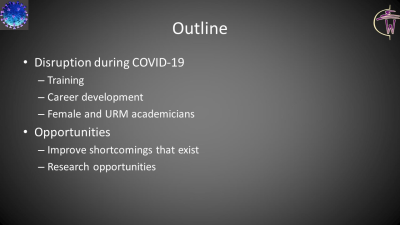Weekday Course
SARS-CoV-2: What We Know, Lessons Learned & Where We May Be Headed: Disparities & Misdirection in a Pandemic
ISMRM & SMRT Annual Meeting • 15-20 May 2021

| Concurrent 7 | 12:00 - 12:30 | Moderators: Elizabeth Hecht & Chris Kokkinos |
| Bedside MRI - Disruptions & Opportunities in Clinical Imaging Due to SARS-CoV-2
Justin Glavis-Bloom, Brian Yep, Lu-Aung Masudathaya, Jennifer Soun, Edward Kuoy, Lori Norrick, Sara Stern-Nezer, Wengui Yu, John Fox, Daniel Chow
Point-of-care, bedside MRI represents a promising new technology for imaging emergent and critical care patients. Whereas in the past, resources were needed to assemble teams that included critical care nurses, respiratory therapists, and transport teams to bring patients to and from radiology departments, there is a dramatic reduction in personnel for POC imaging. This feature was especially important during the COVID pandemic to improve availability of our respiratory therapists and nurses. More studies are needed in the future to ascertain its diagnostic sensitivity and specificity for neurologic findings.
|
||
 |
Disruptions & Opportunities in Training & Early Career During a Pandemic
Mahmud Mossa-Basha
COVID-19 has resulted in significant disruption to training and early career development for academic faculty and trainees alike, with disproportionate impact on females, parents with young children, and underrepresented minorities. In this talk, we highlight the obstacles faced by these groups in general and the way in which the pandemic has exacerbated these disparities. We also highlight potential programs and approaches academic departments can take to mitigate these disparities. The lecture also discusses the general impact on research, training, and education, as well as opportunities that have developed through COVID funding mechanisms and research.
|
|
| Healthcare Disparities & Public Health Policy Exposed by the Pandemic
Anand Narayan
|
||
| Separating Fact Versus Fiction in a Pandemic: Social Responsibilities of Clinicians & Researchers?
Joseph Osborne
Over the last year, hospitals and Radiology departments -- particularly in New York City are -- have been inundated with cases of COVID-19 from the SARS-CoV-2 virus. This period of time has been very difficult, but has also forced introspection to discover where we as imagers can participate in solutions in this accelerated healthcare environment. This includes those who develop imaging probes, design imaging devices as well as those involved in direct patient care.
|
The International Society for Magnetic Resonance in Medicine is accredited by the Accreditation Council for Continuing Medical Education to provide continuing medical education for physicians.